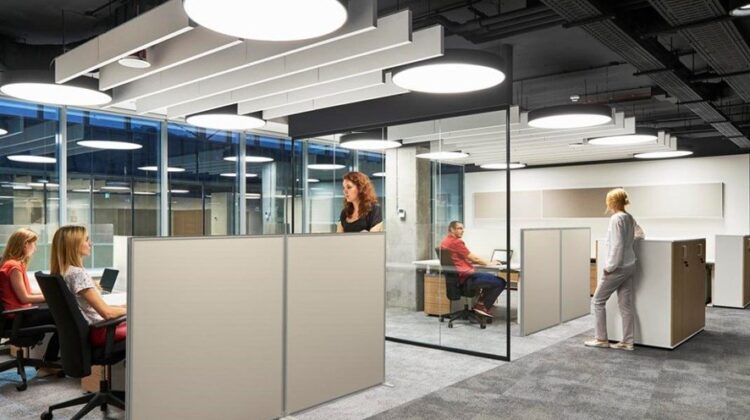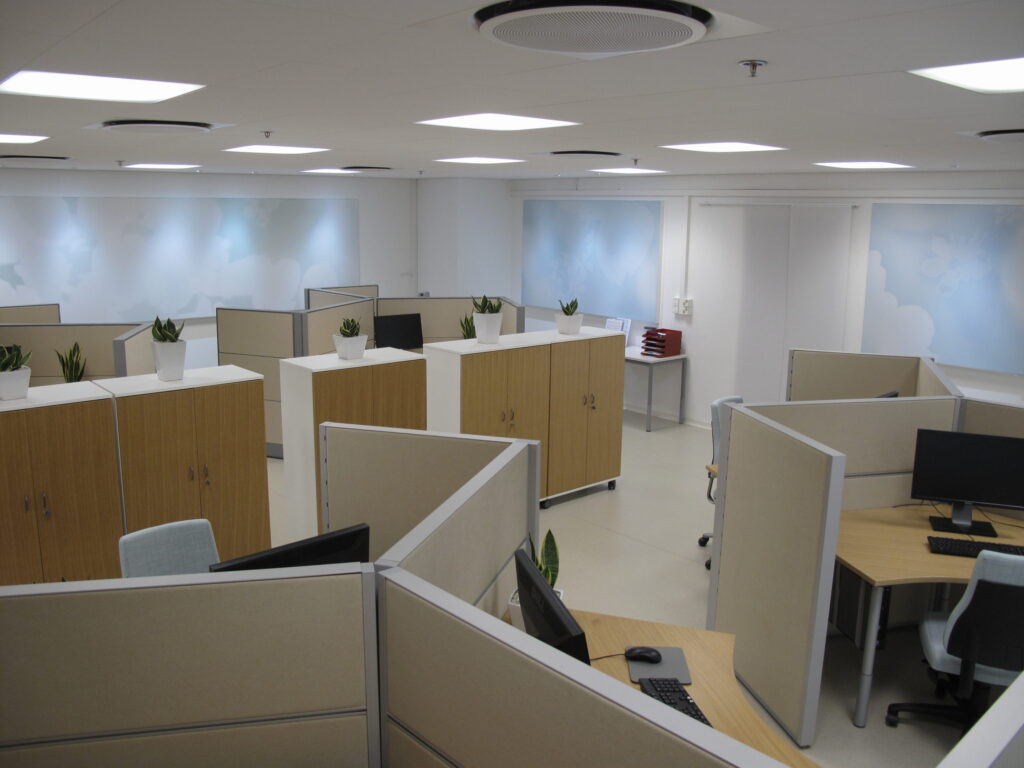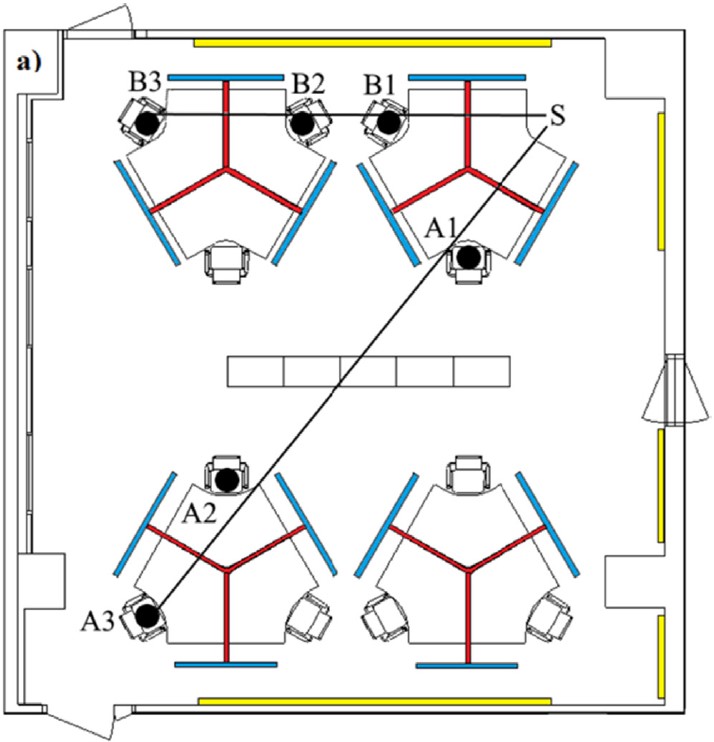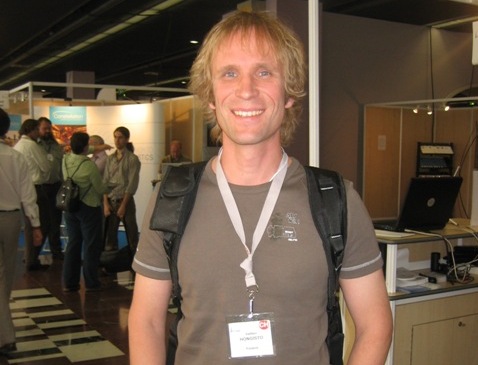
What exactly can you expect from different kinds of acoustic treatment? Which types of treatment should be prioritised and how does one treatment affect the other? In this post we interview Dr. Valtteri Hongisto about a unique and comprehensive study that provides new insights into effective acoustic design of offices.
Researchers Valtteri Hongisto, Jukka Keränen and Jarkko Hakala are the minds behind a detailed study of how different acoustic measures affect the level of irrelevant speech – the main source of distraction in open-plan offices.
An impressive 22 configurations were built in a real open-plan office and studied to document potential interdependent effects and reveal what level of acoustic treatment is required to achieve certain target values for acoustic quality. This study is consequently an important step on the way to achieving better acoustic conditions for workers all over the world.
Valtteri Hongisto is a research group leader at Turku University of Applied Sciences in Finland and one of the most prolific building acoustics researchers in the world today. We met with Valtteri to interview him about the study and understand the thoughts behind it.

Background and context
[Acoustic Bulletin]
“Can you tell us a little about the basic ideas behind this room acoustic study?”
[Valtteri Hongisto]
“This study is first and foremost meant to serve the acoustic designer, to provide evidence-based data showing how different acoustic measures affect room acoustic conditions. The results also show which configurations of measures have the most significant effect, thus making it easier to prioritise different combinations of acoustic treatment.”
The spatial decay rate of A-weighted speech – D2,S – is a variable defined in the ISO 3382-3 standard. It specifies the reduction in the A-weighted sound pressure of speech, in decibels, when the distance to the source is doubled. In 22 different configurations of acoustic treatment, from the least extensive to the most extensive, D2,S ranged from 1.3 to 8.5 dB. To anyone familiar with this acoustic descriptor, changing from 1.3 dB to 8.5 dB makes a world of difference in any office.
The study confirmed that the most effective surface to treat acoustically was the ceiling. However, covering the ceiling with absorbers is not enough.

[Acoustic Bulletin]
“As you rightly touch on in the room acoustic study itself, this publication is rather unique compared to other academic publications within this domain. Could you reiterate why this study is special compared to similar studies done previously?”
[Valtteri Hongisto]
“This study is unique, as we physically built 22 configurations of acoustic treatment in a real office which measures 90 square metres and has 12 workstations. Implementation of each configuration required quite a lot of physical work. All materials used were commercially available and the outcomes looked professional. We also used the same space in a series of four psychological experiments. These experiments tested how ventilation rate, room temperature, interior design, and room acoustics affected the cognitive performance of humans. In total we have now published 9 papers from this open-plan office.”
In 2018, Acoustic Bulletin covered the presentation of one of these psychological studies at Euronoise Crete, in which Valtteri and his colleagues studied the level of distraction caused by different kinds of indoor environmental factors. You can find a brief summary of this study in this acoustic bulletin post: https://www.acousticbulletin.com/euronoise-2018-room-acoustic-design-and-psychological-effects-of-offices

Results and take-aways
[Acoustic Bulletin]
Let’s get back to the room acoustic study. Was there anything that surprised you when reviewing the results?
[Valtteri Hongisto]
“If I had the option of changing something, I would have added even more wall absorbers. This study was conducted some time ago and at that time wall absorbers were used to a lesser degree in offices than nowadays in Finland. We dared cover only 20% of walls with absorbers while 50% coverage is used in many offices nowadays.
So, we were unable to show the effect of wall absorbers to their fullest possible extent. Fortunately, sound-absorbing screens were well represented in our study.
Since wall absorption was never greater than 20%, we could not achieve the same level of spatial decay rate for speech (D2,S > 9 dB) as can be sometimes measured in the field, with larger room sizes or larger wall absorption. The size of the room studied was around 90 m2 and the rather sparse wall absorption meant that reflections from these surfaces contributed to the SPL of speech throughout the room, which in turn caused a lower D2,S.”

In other words, because of the smaller room size, the wall surfaces were quite close to any source or receiving point, which increases the SPL for speech. By the same token the wall area was quite large relative to the floor area of many open-plan offices. A much higher D2,S value would probably have been achieved in a larger office space or in conditions with more wall absorption.
[Acoustic Bulletin]
Could we speculate that the distracting effects of speech would generally be stronger in smaller open-plan office spaces as the walls would contribute to amplification of speech to a higher degree than in larger spaces?
[Valtteri Hongisto]
“Yes, the sound level of standard speech is higher in small rooms than in large rooms, since the energy is divided into a smaller volume. It’s the reason why very small, shared office spaces for about 4–5 people can be highly problematic, as you cannot prevent this effect unless you install an unrealistic amount of wall absorption. The larger the office, the easier it is to control noise by means of acoustic materials.”
[Acoustic Bulletin]
“That is a really interesting perspective on room acoustic design. One that is probably often overlooked when designing open-plan offices. Another very interesting finding in this study is the effect of implementing screens compared with ceiling absorption. Could you tell us a little bit about this finding?”
[Valtteri Hongisto]
“If we are talking about maximising the spatial attenuation of sound then ceiling absorption is number 1 – it is the most important. If there is little ceiling absorption, the effectiveness of screens is reduced. This is clear from our results. The highest priority should be given to a highly absorbent ceiling. Thereafter, it’s useful to invest in sound-absorbing screens. Wall absorbers have the lowest priority, but their importance is crucial if screens are absent or minimal.”

Figure 3 from the study: “The measured D2,S values in the 22 conditions as a function of apparent sound absorption area of the room, AT, for screen heights (a) h = 0.0 m, (b) h = 1.3 m, (c) h = 1.7 m, and (d) h = 2.1 m. The grey fill show conditions with high ceiling absorption (ac = 0.9) and white fill with low ceiling absorption (ac = 0). The circles show results on path A and the squares on path B.”
[Acoustic Bulletin]
“What is next for you in terms of research? You have mentioned that you are carrying out tests to see if you can replicate these results digitally. Is there anything else you are expecting to expand upon in the near future?
[Valtteri Hongisto]
“We are planning a psychological experiment in which we investigate the effect of office noise on cognitive work performance and physiological stress in three conditions: poor room acoustics, good room acoustics, and superior room acoustics. The middle condition corresponds to the Finnish building regulations. It is very interesting to see how much investment in room acoustics affects performance and stress. We already have the results but we expect to publish them next year since the same experiment will also be conducted in another country to see if there are cultural differences.”
You can find the room acoustic study in its entirety here:
https://www.sciencedirect.com/science/article/abs/pii/S0003682X19313325
We at Acoustic Bulletin would like to thank and congratulate Valtteri Hongisto on his research, which supports better sound environments for people all over the world.
If you found this post useful, you might me interested in our Design Dive series on open offices:
Author: Morten Roar Berg, Global Concept Developer for office environments



